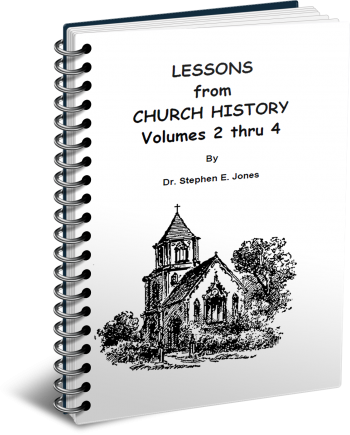Latest Posts
View the latest posts in an easy-to-read list format, with filtering options.

Volumes 2-4. This is the history of the Church from the Roman War (66-73 A.D.) to Constantine and the Council of Nicea in 325 A.D. with lessons to be learned from it.
Category - History and Prophecy

As the third century dawned, Rome had just begun to assert its primacy over the rest of the churches. Ambition and the desire for power are usually symptoms of evil motives, though often soothed by high sounding words designed to make power acquisition seem for the good of all. Historical records reveal this to be the case with the Roman Church.
It was not that Rome had produced any distinguished scholars or personalities that would have earned them the right of primacy. In the first four centuries, Rome produced only two who made any impression upon the Church—Callistus (217-222) and Damasus (366-383). When Victor died at the turn of the second century, the people voted for Zephyrinus to replace him, though Hippolytus was much better educated. Perhaps the people saw too much spiritual pride in Hippolytus to want him as their bishop.
Up to this time, the Church had been careful—perhaps overly careful—to screen the converts, so as not to be overwhelmed by those with low morals who desired to be Christians. New coverts had had to undergo a time of teaching (catechism) before their baptism. Meanwhile, they were considered to be “half Christians.” It is apparent that the Church had long since lost the distinction between faith and baptism (as set forth in the prophetic types of Passover and the Red Sea).
They had also forgotten the origins of baptism (Leviticus 14), in which the priest was not called to heal the leper, but to inspect him to see if God had already healed him. Lev. 14:3-7 says,
{Leviticus 14:3} 3 And the priest shall go out to the outside of the camp. Thus, the priest shall look, and if the infection of leprosy has been healed in the leper, {Leviticus 14:4} 4 then the priest shall take two live clean birds and cedar wood and a scarlet string and hyssop for the one who is to be cleansed. . . {Leviticus 14:7} 7 He shall then sprinkle seven times the one who is to be cleansed from the leprosy, and shall pronounce him clean . . .
If the leper had been healed by God, then the priest was called to bear witness to that divine healing by baptizing him, so that the ex-leper could re-join the congregation (“Church”). The priest was NOT to baptize the leper unless he had already been healed of his leprosy. This is illustrated in Luke 5:14, where Jesus healed the leper and then told him to show himself to the priest “for a testimony” (i.e., “witness”).
This carried into the New Testament, for leprosy speaks of mortality and death. Baptism is a symbolic act of transferring a person from death to life. The priest or minister was not called to do an act of salvation (spiritual healing), but was called only to be a witness to what God had already done in him by faith. Thus, the purpose of baptism was not to bestow salvation, but to bear witness of his faith in Christ which had already justified him before God.
Baptism, then, allowed the believer to join the earthly congregation (“church”), the local community of believers. But the man's prior faith determined his position in the Universal Church, whose names are written in the Book of Life.
This distinction appears to have been lost quite early in the loss of Hebrew influence and when the study of the Apostolic writings largely displaced the study of the law and prophets. The Apostles wrote largely to clarify the law and the prophets and to show how Jesus Christ fulfilled both in His life, death, resurrection, and ascension. The New Testament was not intended to replace the Old Scriptures, but to supplement them and clarify them in the light of Pentecost.
If the Church had retained its Hebrew roots and an understanding of the law, they would have seen that baptism was instituted under Moses. The book of Hebrews, in fact, comments directly upon those “baptisms” performed in the Old Testament in Heb. 9:10, saying,
{Hebrews 9:10} 10 since they relate only to food and drink and various washings [baptismos], regulations for the body imposed until a time of reformation.
These baptisms are also called “sprinkling” in verses 13, 19, and 21. Thus, the author of Hebrews shows his knowledge of the law of the cleansing of lepers in Leviticus 14 as well as the various ceremonial washings performed at the laver in the Tabernacle of Moses. These were performed by sprinkling or pouring to show their heavenly origin.
Most Christians today have read the story of Naaman, the Syrian, who was healed of leprosy by submitting to baptism in 2 Kings 5. In verse 10 the prophet told Naaman to wash [rachats] in the Jordan seven times, according to the law in Lev. 14:7. The text does not actually specify the mode of washing, but verse 14 says,
{2 Kings 5:14} 14 Then he went down and dipped [tabal, “washed”] himself seven times in Jordan according to the saying of the man of God, and his flesh came again like unto the flesh of a little child, and he was clean.
Interestingly enough, the Septuagint (Greek translation of the Hebrew Scriptures) translates tabal above with the Greek equivalent, baptizo, which is the origin of our English word baptism. The Septuagint establishes the Hebrew-Greek equivalents, so that we know how to express Hebrew concepts using Greek words. Because the Septuagint had been completed long before the time of Christ, the Hebrew-Greek equivalents had been established by long usage centuries before the book of Hebrews was written. It is clear, then, that the idea of baptism was established by Moses, not by John the Baptist. John was a priest who learned the art of baptism by observation and by practice in the temple.
The Greek-speaking Church, however, seemed to forget that the terminology of the New Testament was not meant to express Greek ideas but Hebrew concepts that had been long established in the Old Testament. The law’s concept of baptism was one of the casualties of the Greek mindset in the early Church, as the Greek Christians came to interpret the Greek New Testament through the eyes of Greek culture. They adopted Greek definitions of the term and applied it in the same spirit as could be found in the Greek temples.
The Grecian temples initiated people into their “mysteries” by baptism also. In their view, no one could know their god without being so initiated. This carried over into the Church as well, turning baptism into a Greek-style initiation rite, instead of a Hebrew-style double witness of something that God had already done in a man’s heart.
Once the early Church accepted this Greek concept of initiation by baptism, it contributed greatly to the idea that the organizational church was the True Church. This put the bishop or priest into the place of determining, by his act of baptism, who should be saved and who should not be saved. This put God into the place of witnessing man’s saving act, rather than man bearing witness to God’s saving act. In practice, this usurped the place of God and put men’s eternal destiny in the hands of the priesthood which could deny or confer salvation upon any man.
As time passed, there came to be no distinction between a Church member and a true Christian believer, or between the earthly organization and the True Church. The bishop determined who was and who was not a true believer. This is the underlying usurpation of power that transformed Christianity from a relationship with God to a relationship with the organized church and the men who led it.
But such is the nature of the Church as prophesied in the life of King Saul, who usurped power in his belief that he could do as he willed. He thought God had to bear witness to him since he had been anointed king. This condition of the Church was prophesied also in the fact that the Pentecostal offering was leavened (Lev. 23:17). It was prophesied again in the story of Eli, who refused to correct his sons, thus corrupting the priesthood (1 Sam. 2:22-24).
It was at the close of the second century that these problems were great enough to come to the surface. In 192 Victor assumed the power to excommunicate bishops in other parts of the world if they disagreed with the manner in which they celebrated Passover. The assumption was that he had the power not only to exclude people from the church, but also to exclude them from heaven itself.
Victor, then, set the tone for the third century in the history of the Church. From Victor to Constantine the Church began to take the form of religion. Prior to Constantine, the Roman government had used its civil power to suppress Christianity itself. But Constantine, after briefly granting freedom of conscience, was persuaded to use civil power to suppress “heresies” in the attempt to bring unity to the Church and to the Empire.
And so, this book takes us to the point where the Church was granted official status as a religio licita, and to the point in time where the Roman government used its power to help the bishops determine which doctrines were officially Christian and which were heresies. By these means, heretical groups were outlawed and did not enjoy the same status religio licita as the mainstream religion.